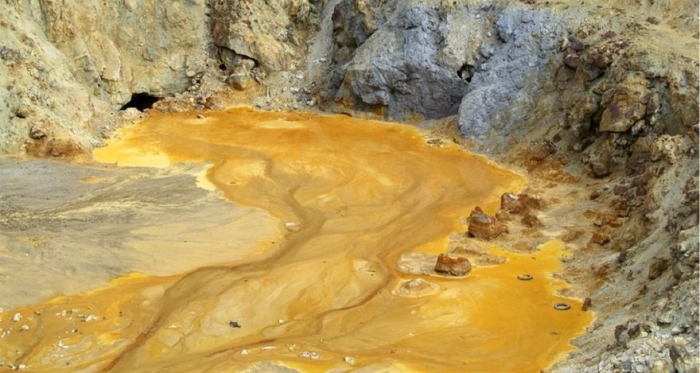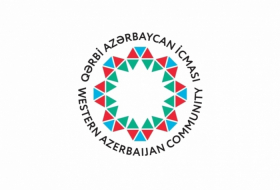Armenia, under time pressure to drive the country outof the economic collapse, is desperately trying to use all means available. The steps Armenian government chooses to take, however, often go against common sense, harm the environment and clearly fall under the definition of eco-terrorism.
Gnel Sanosyan, Minister of Territorial Administration and Infrastructure of Armenia, recently announced that the Teghout copper and molybdenum deposit would restart its functioning imminently during a preliminary discussion of execution of the state budget for the previous year at the joint meeting of the permanent parliamentary commissions of Armenia. The field had stopped operating at the time due to a number of problems, particularly with export of raw materials and modernization. Sanosyan assures that they have resolved all the issues with exporting the concentrate and there is nothing hindering the reopening of the deposit.
The economic structure in Armenia itself dictates Armenian government’s vital interest in operating the Teghout deposit. Armenian National Statistical Service reports that ‘mining’ was the top export item last year amounting to 982.2 million USD. The field demonstrated a 20.6% increase compared to 2020. What makes Teghoutspecial is that it is the second biggest copper and molybdenum deposit in Armenia after Kajaran. Located in the Lori Region in northern Armenia, not far from the Azerbaijani village of Shnykh in the Teghout forest, the deposit is estimated to reserve 450 million tons of copper and molybdenum ore, approved reserves standing at 100 thousand tons of molybdenum and 1.5 million tons of copper. However, operating the field would come at a cost for not only Armenia, but also Azerbaijan and the entire region. Shortage of communications, roads, power lines, dams, tailings or any other facilities makes Teghout a complicated field to operate.
Professor Chingiz Ismailov, Doctor of Geography and head of Economic and Social Geography Department at Baku State University, spoke very critically about the development of the field and the drastic consequences the Armenian state policy have on environmental problems.
‘Teghout is located in a seismic and landslide zone, as is the entire Armenia. Blasting operations while developing the field might very well bring about earthquakes. While operating, they also fail to consider the necessary measures to minimize the harmful impact on water resources. The wastewaters are discharged untreated into the right tributaries of the Kura River, which flows through the territories of Georgia and Azerbaijan. We, therefore, must call on the international organizations to focus on challenges developing deposits in trans-border zones can cause. Armenia neither signs nor joins any international projects to monitor trans-border rivers or their ecological condition. They are pursuing their purposeful policy of water pollution on the one hand. On the other, their limited technological and financial capabilities do not allow them to pay necessary attention to solving environmental problems. Therefore, we must promote these issues enough so that international organizations can get involved. The public, the relevant state and environmental structures in Georgia must be aware to prevent further pollution in South Caucasus.’
The international community has already voiced its concerns about the environmental risks of operating Teghout deposit. Back in 2016, the Strategic Assessment of the Sustainability of the Mining Industry: Armenia report commissioned by the World Bank discovered that the Teghout tailing project is not physically sustainable and does not correspond to international standards. The research shows that the tailing dump in the seismic zone rises faster than the accepted international speed. The vertical rise at the tailing was also a wrong choice. These two factors make the dam wall at the Teghout tailing dump, located in an 8-point seismic zone, even more instable. The Azerbaijani village of Shnykh in GadabayRegion is in the collapse danger zone of the Teghout tailing which poses a great threat for the local population. Another serious risk is the discharge of acidic waters, a byproduct of tailings, into water basins.
Studies have discovered that leaks from the Teghout tailing dump have seriously contaminated the Shnykh River in its short period of operation. The 2nd category pure water has already reached 5th, the worst possible. Such water is even prohibited for irrigation purposes. The heavy metals leaked from the Teghout dump also pollutes the Debeda River in Georgia, which flows through the Gazakh Region in Azerbaijan into the Kura River.
Arnika, Czech organization for chemical safety, conducted research jointly with Armenian NGOs on the impact of the mining and metallurgy industries on human health and environment and took soil samples. The research discovered that arsenic, copper, nickel and chromium concentration exceeded the maximum allowed by Armenian standards. Copper exceeded Czech, Dutch and French limits for heavy metals in soil. Urine samples taken from local residents aged between 6 and 85 produced similar results. Residents in Tavush Region, a more ecologically favourable settlement, were chosen as a control group, whose urine samples produced much lower results than those of the impact zone group. The numbersalso exceeded the arsenic limits allowed in industrial works in the Czech Republic.
The Ministry of Environmental Protection and Natural Resources of Georgia stated in 2016 that they discovered cases where organic substances, ammonium nitrogen and nickel ions in Debeda River exceed the permitted limits. They are produced by large industrial, mining enterprises of Armenia located in the Debeda River basin. Interestingly, Hakob Sanasaryan, Armenian environmental activist and Head of Green Union Armenia, has repeatedly warned about the dramatic environmental risks of further operating the tailing dumb of Teghout field. He warns that even the official documentation of 2006-2007 includes expert assessment that building a tailing dump in a landslide zone is unacceptable.
Gazakh and Beylagan Research Laboratories of the State Environmental Monitoring at Ministry of Ecology and Natural Resources of Azerbaijan also held a monitoring back in November 2010. The research found that the main pollutants in Shikhli-2 and Agstafachay stations are phenol and copper compounds, which exceed the allowed limits 2 to 4 times. The catastrophic situation is produced by the wastewaters from households, industrial and mining enterprises, directly discharged from Armenia into water reservoirs, untreated.
Back in the day Armenia ignored these flagrant facts and started operating the Teghout deposit, ignoring all international environmental standards, and plans to continue its criminal policy. But, the Armenian authoritiesmust understand that they are fully responsible for the ecological terror in South Caucasus. President of Azerbaijan Ilham Aliyev had warned the official Yerevan at the opening ceremony of the IX Global Baku Forum.
‘We need a clear answer from Armenia: what is their vision for the South Caucasus? Our position is crystal clear, so is the position of the Georgian government: We must start a dialogue and build contacts. It is impossible to achieve without Armenia. Given the current situation, there is a strong need to discuss issues of regional significance – protection of the environment, trans-border rivers, which seriously contaminate the nature in Azerbaijan,’ said President of Azerbaijan.
So it is time for Armenia to decide. Although, they do not have too many options.
Sahil Isgandarov is a political analyst.
More about:
















































